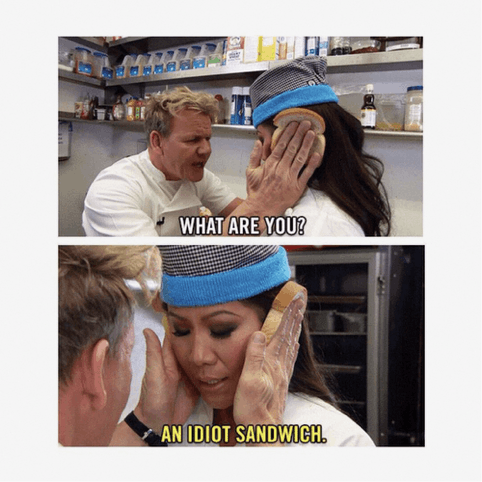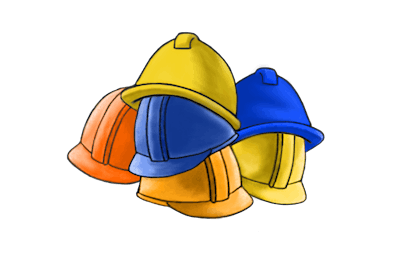Recently we’ve been writing some Workplace Health and Safety (WHS) content that has been been turning heads. And if you don’t believe me, I’ve got proof...

Now while that doesn’t prove anything other than the fact that I use a lot of memes in my blog posts (warning: more memes to come), I am going to show you how we’ve been doing it.
So I'll show you 4 different ways to present WHS content:
- Facts
- True/False questions
- Multiple-choice questions (we do this one)
- Learning from consequences (and this one!)
And just so we are on the same page, WHS is just like OH&S, but they changed the letters. So its safety in the workplace, which means everything from sitting down in your chair the right way, all the way through to removing asbestos (this is what we will be having a look at).
1. Facts
The most basic way is just to give the learner a summary and present it to them either face to face, or in some written materials (often online). Something along the lines of:
“Asbestos must be removed by a licensed professional unless it is non-friable and is less than 10 metres squared.”
Now if you have been given pages and pages and pages of training material, or it comes in hour 3 of a 6 hour classroom facilitated training session, this point may get lost. So how can we check you didn't just passively take this information in? Well...we ask a question!
2. True/False Questions
Asking a question is better. But not all questions are created equal. And true or false questions - well they give us the heebie jeebies.
But they're often what you will find at the end of a WHS course to test that you have "learned." You'll probaly have questions at the end of the course like:
“Asbestos over 10 metres squared needs to be removed by a licensed professional. True/False”
OR
“Non-friable asbestos must always be removed by a licensed professional. True/False.”
Now this is actually getting better, at least you might have to think for almost half a second to remember what you learned.
But it’s still not great – it's not even good.
We’re a company that thrives on writing great questions. And if I were to give these two questions to Joel, our Head of content, he might give me a Gordon Ramsay impression.

Now that's a lie. But mostly because Joel is just too damn nice to put 2 slices of bread either side of my head!
But that doesn't mean they aren't poorly written questions.
So how can we do better?
Our Yarno platform has a question space, 4 possible answers and an explanation space. But let me show you how powerful that can be when we add a couple of key ingredients

3. Scenario based multiple choice
Let's change that true or false question to a multi-choice question with 4 plausible distractors to really get the learner thinking.
“You find a 3 metre squared area of asbestos. When would a fully qualified and licensed removalist be required to remove this area?”
A. If it is found to be friable asbestos
B. Always for the removal of asbestos
C. If it is found to be bonded asbestos
D. Never, as it is less than 10 metres squared
This is a scenario based question where only genuine knowledge will pass - this is the format we have built Yarno on thus far. It makes the learner recall both the types of asbestos, as well as the 10 metres squared standard in order to correctly select A.
And if the learner makes an incorrect decision, we will provide them with an explanation so they get instant feedback on their answer. But can do one better? Yes we can.
4. Learning from Consequences
We can write a decision making (mini-branching) scenario. This will allow our learner to do something championed by learning guru Cathy Moore - learn from the consequences of their actions. The ability to do this is still on our product roadmap, but it should be coming soon, and wow is it powerful.
Note: this is a very crude example, so we can give a simple demonstration.
“You're inspecting a job site and someone reports an area about 3 metres squared which is suspected of being asbestos. What should you do next?"
A. First determine the kind of asbestos and then re-evaluate
B. Employ a licensed professional to remove the asbestos
C. Have a worker on site remove the asbestos immediately
Now this question is quite similar to option 3, but where it finds its real power is in the explanation. And when a learner sees one consequence, they can then go back to the start of the question and explore the other options.
Lets say we pick Option C:
C. You have a worker on site remove the asbestos
Consequence: The worker does as they are told and removes the asbestos. But they weren't trained to remove the asbestos and later complain to WorkSafe which causes legal issues for your company.
Now notice we didn’t say - you are wrong. Instead, we just showed you a consequence and you will do the learning off the back of it.
Let's go explore some other options and pick B:
B. Employ a licensed professional to remove the asbestos
Consequence: the licensed professional comes out to remove the asbestos at a high cost, but it turns out to be non-friable. The removalist tells you that someone on site could've removed the asbestos if they were trained. It would've been a fraction of the cost.
Now this is a more correct choice, you have kept all workers on site safe, though you have incurred an unnecessary cost.
So let's explore the final option, A:
A. Determine the kind of asbestos and then re-evaluate
Consequence: you determine the asbestos is non-friable. You therefore have the option to either hire a professional, or have a trained worker on site do it for a fraction of the cost.
This is the best decision.
So now we've seen 4 differnet ways of presenting the content, let's look at how our learner experience evolved.
We have gone from a learner who just passively takes in information, to something far more powerful.
Now our learners are making decisions in a realistic scenario that can help to really change behaviour. We can do this all with just a question, some answers and an explanation, something so accessible that we've got a friendly team and a web-app that can help you do it.

To learn about the big impact little bites of learning can have,download our microlearning white-paper.
